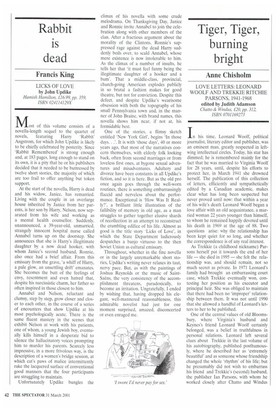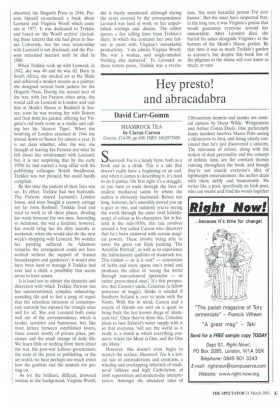Tiger, Tiger, burning bright
Anne Chisholm
LOVE LETTERS: LEONARD WOOLF AND TREKIUE RITCHIE PARSONS, 1941-1968 edited by Judith Adamson Chatto & Windus, 120, pp. 312, ISBN 0701169273 In his time. Leonard Woolf, political journalist, literary editor and publisher, was an eminent man, greatly respected in leftwing intellectual circles. Today, his star has dimmed; he is remembered mainly for the fact that he was married to Virginia Woolf for 28 years, until, despite his efforts to protect her, in March 1941 she drowned herself. The publication of this collection of letters, efficiently and sympathetically edited by a Canadian academic, makes clear what has long been suspected but never proved until now: that within a year of his wife's death Leonard Woolf began a love affair with an old acquaintance, a married woman 22 years younger than himself, to whom he remained happily devoted until his death in 1969 at the age of 88. Two questions arise: why the relationship has been kept quiet for so long, and whether the correspondence is of any real interest.
As Trekkie (a childhood nickname) Parsons herself put it towards the end of her life — she died in 1995 — she felt the relationship was, and should remain, not so much secret as private. In 1971 Leonard's family had brought an embarrassing court case, which Trekkie eventually won, contesting her position as his executor and principal heir. She was obliged to maintain that there had been no 'improper' relationship between them. It was not until 1990 that she allowed a handful of Leonard's letters to her to be published.
One of the central values of old Bloomsbury, where Virginia's husband and Keynes's friend Leonard Woolf certainly belonged, was a belief in truthfulness in personal relations. Leonard left several clues about Trekkie in the last volume of his autobiography, published posthumously, where he described her as 'extremely beautiful' and as someone whose friendship changed the whole 'rhythm' of his life; but he presumably did not wish to embarrass his friend and Treldcie's (second) husband, the publisher Ian Parsons, with whom he worked closely after Chatto and Windus absorbed the Hogarth Press in 1946. Parsons himself co-authored a book about Leonard and Virginia Woolf which came out in 1977. It was dedicated to Trekkie and based on 'the Woolf archive' (includ ing these letters) that she had given to Sussex University, but her true relationship with Leonard is not disclosed, and the Parsons remained married until he died in 1980.
When Trekkie took up with Leonard, in 1942, she was 40 and he was 62. Born in South Africa, she studied art at the Slade and achieved a modest success as a painter; she designed several book jackets for the Hogarth Press. During the second year of the war, with Ian Parsons often away, she would call on Leonard in London and visit him at Monk's House at Rodmell in Sussex; soon he was wooing her with flowers and fruit from his garden, offering her Virginia's old work room as a studio and calling her his 'dearest Tiger'. When the bombing of London resumed in 1944 she moved down to Sussex for almost a year. It is not clear whether, after the war, she thought of leaving Ian Parsons nor what he felt about her involvement with Leonard; but it is not surprising that by the early 1950s he had started a long affair with his publishing colleague Norah Smallwood. Trekkie was not pleased, but could hardly complain.
By this time the pattern of their lives was set. In effect, Trekkie had two husbands. The Parsons shared Leonard's London house, and soon bought a country cottage not far from Rodmell. Trekkie lived and tried to work in all three places, dividing her week between the two men. According to Adamson, she was a feminist: however, Ian would bring her his dirty laundry at weekends, when she would also do the next week's shopping with Leonard. No wonder her painting suffered. As Adamson remarks, the arrangement could not have worked without the support of 'trusted housekeepers and gardeners'; it would also have been hard to manage if Trekkie had ever had a child, a possibility that seems never to have arisen.
It is hard not to admire the dexterity and discretion with which Trekkie Parsons ran her unconventional, complex, exhaustingsounding life and to feel a pang of regret that the relentless intrusion of contemporary curiosity has exposed the triangle once and for all. She and Leonard both come well out of the correspondence, which is tender, sensitive and humorous; but, like most letters between established lovers, these consist mostly of private jokes, petnames and the small change of daily life. We learn little or nothing from them about the war, the post-war Labour government, the state of the press or publishing, or the art world; we hear perhaps too much about how the gardens and the animals are getting on.
As for the brilliant, difficult, drowned woman in the background, Virginia Woolf, she is barely mentioned, although during the years covered by the correspondence Leonard was hard at work on her unpublished writings and diaries. The editor quotes a few telling lines from Trekkie's diary, in which she contrasts her own failure to paint with Virginia's remarkable productivity, 'I do admire Virginia Woolf. She was a worker, and single-minded. Nothing else mattered.' To Leonard, as these letters prove, Trekkie was a revela tion, 'the most beautiful person I've ever known'. But she must have suspected that, in the long run, it was Virginia's genius that would guarantee everyone around her immortality. After Leonard died, she buried his ashes alongside Virginia's at the bottom of the Monk's House garden. By that time it was as much Trelthe's garden as anyone's, but despite this book few of the pilgrims to the shrine will ever know as much, or care.



























































































 Previous page
Previous page